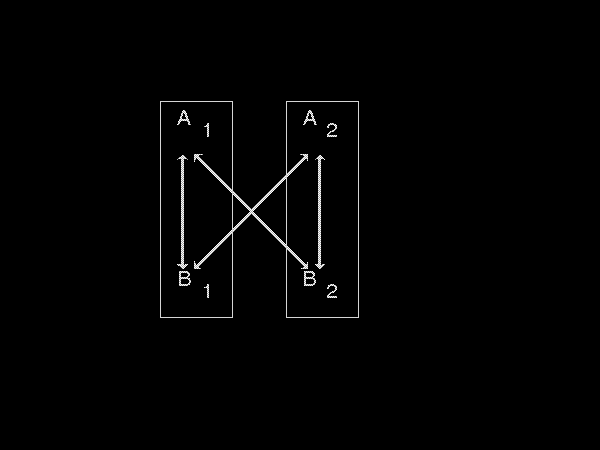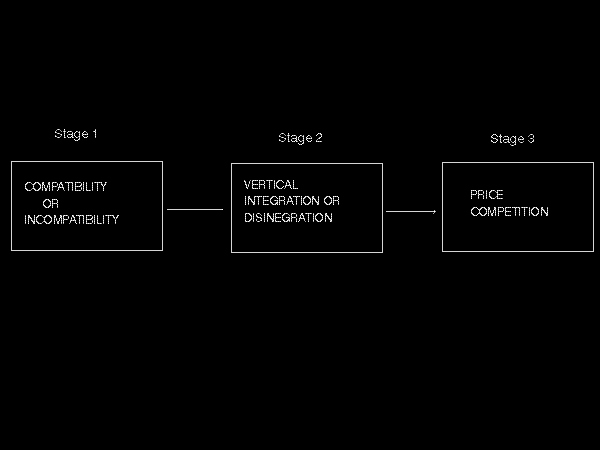
3.3.1 Mix and Match: Compatibility vs. Incompatibility
The mix-and-match literature does not assume a priori network externalities; however, it is clear that demand in mix-and-match models exhibits network externalities. The mix-and-match approach was originated by Matutes and Regibeau (1988), and followed by Economides (1988, 1989, 1991a, 1991b, 1993c), Economides and Salop (1992), Economides and Lehr (1995), Matutes and Regibeau (1989, 1992), and others. To fix ideas, consider the case of Figure 4 with m = 2, n = 2, technologies are known, coordination is costless, price discrimination is not allowed, and there are no cost asymmetries created by any particular compatibility standard. Figure 7 shows the case of compatibility. The incentive for compatibility of a vertically integrated firm (producing A1 and B1) depends on the relative sizes of each combination of complementary components. Reciprocal compatibility, (i.e., simultaneous compatibility between A1 and B2, as well as between A2 and B1) increases demand (by allowing for the sale of A1B2 and A2B1) but also increases competition for the individual components. Therefore, when the hybrid demand is large compared to the own-product demand (including the case where the two demands are equal at equal prices), a firm has an incentive to want compatibility.20 When the demand for hybrids is small, a firm does not want compatibility. Thus, it is possible, with two vertically integrated firms, that one firm wants compatibility (because it has small own-product demand compared to the hybrids demand) while the other one prefers incompatibility (because its own-product demand is large compared to the hybrids demand). Thus, there can be conflict across firms in their incentives for compatibility, even when the technology is well known. The presumption is that opponents will not be able to counteract and correct all incompatibilities introduced by an opponent, and, therefore, in situations of conflict we expect that incompatibility wins.

Figure 7: Mix-and-match compatibility.
These results hold both for zero-one decisions -- i.e., compatibility vs. incompatibility -- and for decisions of partial (or variable) incompatibility. The intuition of the pro-compatibility result for the zero-one decision in the equal hybrid- and own-demand is simple. Starting from the same level of prices and demand in both the compatibility and incompatibility regimes, consider a price increase in one component that produces the same decrease in demand in both regimes. Under incompatibility, the loss of profits is higher since systems sales are lost rather than sales of one component. Therefore, profits are more responsive to price under incompatibility; it follows that the residual demand facing firms is more elastic under incompatibility, and therefore firms will choose lower prices in that regime.21 This is reminiscent of Cournot's (1838) celebrated result that a vertically integrated monopolist faces a more elastic demand and will choose a lower price than the sum of the prices of two vertically-disintegrated monopolists.22 So far we have assumed that compatibility is reciprocal -- i.e., that the same adapter is required to make both A1B2 and A2B1 functional. If compatibility is not reciprocal -- i.e., if different adapters are required for A1B2 and A2B1 -- the incentive of firms to achieve compatibility depends on the cross substitution between own-products and hybrids. Roughly, if the substitutability among A-type components is equal to the substitutability among B-type components, the earlier results of the reciprocal setup still hold.23 Nevertheless, if the degree of substitutability among the As is different than among the Bs, one firm may create an advantage for itself by introducing some incompatibilities. However, it is never to the advantage of both vertically integrated firms to create incompatibilities.
The issue of compatibility and coordination is much more complicated if there are more than two firms. A number of coalitions can each be formed around a specific technical standard, and standards may allow for partial compatibility, or may be mutually incompatible. Not enough research has been done on this issue. Research in this area is made particularly difficult by the lack of established models of coalition formation in non-cooperative settings. The analysis based on coalition structures is more complicated in the "micro" approach because of the specifics of the ownership structure.

Figure 8: Compatibility decisions are less flexible than vertical integration decisions
The studies we referred to this far take the ownership structure as given (i.e., as parallel vertical integration), and proceed to discuss the choice of the degree of compatibility. In many cases, vertical integration is a decision that is more flexible (and less irreversible) than a decision on compatibility. Thus, it makes sense to think of a game structure where the choice of technology (which implies the degree of compatibility) precedes the choice of the degree of vertical integration. Economides (1996b) analyzes the choice of asset ownership as a consequence of the choice of technology (and of the implied degree of compatibility). It posits a three-stage game of compatibility choice in the first stage, vertical integration in the second stage, and price choice in the third stage. Incentives for vertical mergers in industries with varying degrees of compatibility are compared. In analyzing the stage of compatibility choice, the influence of the anticipation of decisions on (vertical) industry structure on compatibility decisions is evaluated.